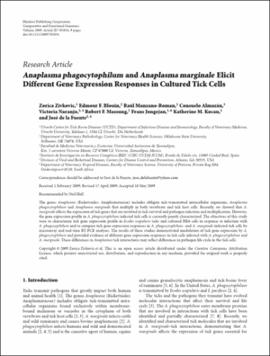| dc.contributor.author | Zivkovic, Zorica | |
| dc.contributor.author | Blouin, Edmour Francis | |
| dc.contributor.author | Manzano-Roman, Raul | |
| dc.contributor.author | Almazan, Consuelo | |
| dc.contributor.author | Naranjo, Victoria | |
| dc.contributor.author | Massung, Robert F. | |
| dc.contributor.author | Jongejan, Frans | |
| dc.contributor.author | Kocan, Katherine M. | |
| dc.contributor.author | Fuente, Jose de la | |
| dc.date.accessioned | 2019-08-22T17:51:01Z | |
| dc.date.available | 2019-08-22T17:51:01Z | |
| dc.date.issued | 2009 | |
| dc.identifier | oksd_zivkovic_anaplasmaphagoc_2009-01-01 | |
| dc.identifier.citation | Zivkovic, Z., Blouin, E. F., Manzano-Roman, R., Almaz�n, C., Naranjo, V., Massung, R. F., Jongejan, F., Kocan, K. M., & Fuente, J. d. l. (2009). Anaplasma phagocytophilum and Anaplasma marginale elicit different gene expression responses in cultured tick cells. Comparative and Functional Genomics, 2009. https://doi.org/10.1155/2009/705034 | |
| dc.identifier.uri | https://hdl.handle.net/11244/321261 | |
| dc.description.abstract | The genus Anaplasma (Rickettsiales: Anaplasmataceae) includes obligate tick-transmitted intracellular organisms, Anaplasma phagocytophilum and Anaplasma marginale that multiply in both vertebrate and tick host cells. Recently, we showed that A. marginale affects the expression of tick genes that are involved in tick survival and pathogen infection and multiplication. However, the gene expression profile in A. phagocytophilum-infected tick cells is currently poorly characterized. The objectives of this study were to characterize tick gene expression profile in Ixodes scapularis ticks and cultured ISE6 cells in response to infection with A. phagocypthilum and to compare tick gene expression responses in A. phagocytophilum- and A. marginale-infected tick cells by microarray and real-time RT-PCR analyses. The results of these studies demonstrated modulation of tick gene expression by A. phagocytophilum and provided evidence of different gene expression responses in tick cells infected with A. phagocytophilum and A. marginale. These differences in Anaplasma-tick interactions may reflect differences in pathogen life cycle in the tick cells. | |
| dc.format | application/pdf | |
| dc.language | en_US | |
| dc.publisher | Hindawi Publishing Corporation | |
| dc.rights | This material has been previously published. In the Oklahoma State University Library's institutional repository this version is made available through the open access principles and the terms of agreement/consent between the author(s) and the publisher. The permission policy on the use, reproduction or distribution of the material falls under fair use for educational, scholarship, and research purposes. Contact Digital Resources and Discovery Services at lib-dls@okstate.edu or 405-744-9161 for further information. | |
| dc.title | Anaplasma phagocytophilum and Anaplasma marginale elicit different gene expression responses in cultured tick cells | |
| osu.filename | oksd_zivkovic_anaplasmaphagoc_2009-01-01.pdf | |
| dc.description.peerreview | Peer reviewed | |
| dc.identifier.doi | 10.1155/2009/705034 | |
| dc.description.department | Veterinary Pathobiology | |
| dc.type.genre | Article | |
| dc.type.material | Text | |
| dc.subject.keywords | biology | |
| dc.subject.keywords | genetics | |
| dc.subject.keywords | anaplasma phagocytophilum | |
| dc.subject.keywords | anaplasma marginale | |
